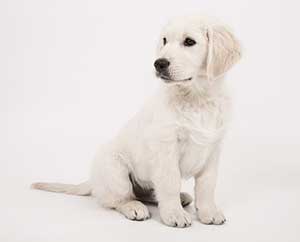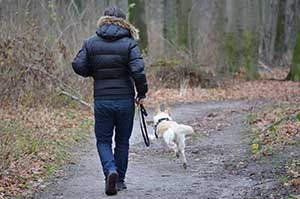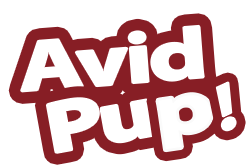
Golden Retrievers are one of the most popular breeds out there. With their lovable attitudes and fierce loyalty, they make great companions for families, new dog owners, and homes with multiple furry friends.
Despite all of their great qualities, Golden Retriever puppy training is not always easy. Young puppies are full of energy.
In most cases, those high energy levels remain long after they’ve reached adulthood.
This personality trait stems from their history as hunters and workers.
If you have a rambunctious puppy that needs to be reined in, you’re going to have to be consistent and prepared during the training process.
13 tips and tricks to successfully train your Golden Retriever puppy.
#1. Plan Ahead
Before you even bring your puppy home, you should start thinking about the training process.
The first few days at home can be overwhelming for both you and your new puppy. The last thing you want to do is wing it.
It’s better to have an established plan in place to ensure that your puppy has all the tools they need to learn.
– Decide What Skills Your Puppy Should Know
Understanding what you want your puppy to know is an important first step.
The puppy years are a crucial time in any dog’s life. Golden Retrievers are very moldable, so you can develop a lot of skills during this time.
As their name suggests, Golden Retrievers excel as hunters. They’re very reactive to outside stimuli, so if you want a hunting partner, you need to start planning for those skills now.
Alternatively, your dog can just be a companion for you and your family. In that case, they’ll still need to learn obedience skills and potty training.
Consider your lifestyle and do some research on the things you can teach your puppy.
– Gather Your Supplies
Golden Retriever puppy training is going to take a lot more than just good intentions and the sound of your voice. There are a lot of supplies you’ll need to ensure that your training is successful.
In addition to all the puppy essentials, you’re going to want to invest in training treats, a sturdy leash, some toys, and so much more.
#2. Choose Your Training Method and Stick to It
There are a couple of different training methods you can go with.
The most common is voice commands. With this method, you’ll need to create identifiable words or phrases that you will teach your dog to remember.
Plan these commands out and write them down. Changing commands in the middle of training will only confuse your puppy and set the process back.
Another method is to use an object that produces a sound.
Whistle training and click training work on the same principles as training with voice commands. However, instead of saying commands, you use the device.
Golden Retrievers are very responsive to whistle training. Whistles produce a distinct sound that can be heard from a good distance away.
Though, if you choose to use a dog whistle or clicker, you’ll need to create your sound patterns and invest in a solid device that can last for many years.
#3. Begin the Training Process as Soon as Possible

It’s never too early to start training your puppy. In fact, the earlier you begin, the easier it will be to develop good habits.
Most dog owners bring their pups home at around six to eight weeks of age.
While you may be tempted to let your dog have a few days of worry-free living when you first bring them home, it’s not a good idea.
Your puppy may start to develop bad habits straight off the bat. If you don’t address these issues, your dog will see that there are no repercussions to their actions.
Start building that trust as soon as possible. Golden Retrievers are very intelligent creatures, so they’ll have no problem picking up training techniques at only a few months old.
#4. Keep Things Simple
Chances are, there are many different skills your dog needs to know to be a happy and healthy member of your family. However, you need to take things one step at a time.
While they are intelligent, they’re not going to be able to process multiple commands at one time. Start with an easy command, such as “Sit,” before you move onto something more complex like “Roll Over.”
– Keep Training Sessions Short
Another thing you’ll need to keep in mind is your puppy’s short attention span.
Golden Retriever puppies are little bundles of energy that want nothing more than to run around and play.
To ensure that your puppy is focused and able to retain their skills, keep training sessions less than 15 minutes long.
You can do multiple sessions throughout the day, but make sure that your puppy has had time to relax and have fun in between them.
#5. Start with House Training
The first skill your dog needs to learn is house training. Young puppies don’t have the ability to hold it in as older dogs do. As a result, they’re very prone to having accidents.
To keep your house as mess-free as possible, you should establish a training routine the moment your puppy gets home.
– Set a Few Days Aside
Potty training requires round-the-clock attention. It’s always recommended that you take a few days off from work and other commitments to spend time with your new puppy.
Not only does this help to develop your bond quickly, but you can use these days to start the potty training process.
When you’re there to support your puppy and teach them where they need to do their business, there’s a much lower chance that they’ll develop bad habits.
– Bring Your Puppy Out Frequently
Start by bringing them out to their potty spot. This can be outside in your backyard or on a training pad inside.
Whatever the case may be, let them have a good sniff around so that they can get comfortable with the area.
Take them out to the spot a couple of times an hour.
While this may seem excessive, you’ll quickly realize that puppies urinate a lot. Bringing them out to the spot frequently will familiarize them with the area and help them understand that connection.
You should always bring your puppy out 20 minutes after they have eaten.
This is usually when they’ll need to go. Also, keep a close eye on your pup at all times. If you ever see them starting to pee or poop, quickly pick them up and bring them to their spot.
#6. Consider Using a Crate
Crates can be a great tool in your training arsenal. They’re a catch-all piece of gear.
A crate can be used for house training, obedience, and safety. If you ever have to leave your puppy alone, the crate will ensure that they can’t get into any trouble.
It’s recommended that you use the crate at night as well.
Over time, your puppy will start to see the crate as a place of comfort. They’ll go to it whenever they’re scared, tired, or just want to be alone.
By introducing a crate early on in their lives, you can rest easy knowing that they’re comfortable using one.
This can prove to be useful whenever you need to take your puppy to the vet or on an airplane.
Typically, owners will stop using the crate full-time once their puppy has reached adulthood, using it only when it’s necessary.
#7. Socialization is Key
Training is not just about teaching your puppy cool tricks. It’s about shaping their behavior and teaching them the difference between right and wrong.
Socialization is a key part of this process. It’s very easy to spot a dog that hasn’t been exposed to other people or animals. They’ll often show signs of aggression or anxiety at the very sight of something unfamiliar.
To ensure that this doesn’t become a problem for your Golden Retriever puppy, you need to start the socialization process as soon as your dog is able to.
This should happen after they’ve gotten all of their shots.
Though, it’s also a good idea to bring new people into your home to meet your puppy beforehand. With proper socialization, your dog will be comfortable around new stimuli that they don’t typically experience at home.
#8. Stop Bad Behavior Early On

When you first start the training process, your precious puppy doesn’t have a good understanding of what they shouldn’t be doing. They’re going to do some stuff that you don’t like.
For example, they may start to chew on your furniture, climb on your bed, or even bite you. It’s important that you put a stop to this behavior as soon as possible.
They don’t know any better, so you have to show them.
Something as simple as saying “No!” is enough to show them that the behavior is not acceptable.
You can also show them a good alternative. For example, if your dog chews on your favorite pair of shoes, take them away and put a toy in their mouth.
– Biting
Biting is one of the biggest examples of bad behavior that you need to stop early on.
While their bites may not hurt now, they will in a few short months. Puppies play with each other by fighting and biting. Naturally, this same type of behavior will happen when they’re playing with you.
If they bite your hand or finger, provide them with a chew toy and say “No!” You could also feign pain by yelping. This makes your puppy think that they injured you, which is not something they want to do.
#9. Be Consistent and Develop a Routine
Golden Retriever puppies need structure in their lives. They thrive when they’re on a routine. You should establish a schedule as soon as possible to help your puppy succeed.
This applies not only to training but every other activity they do.
Provide them with their meals at the same times every single day. If you take walks around the block, try to do so at a predetermined time.
This structure gives them something to look forward to and helps to establish what is expected of them.
Once they’re house trained, they’ll have a good idea of when they get to go out. This can ultimately reduce behavioral problems in the long run.
When it comes to consistency, you need to do things the same way each and every time. While slight discrepancies won’t have a drastic effect on their overall progress, big changes will.
For example, if you started out with voice commands and suddenly decided to adopt whistle training techniques, your puppy will have no idea of what you want from them.
Be consistent in your training and everyday lives to ensure that your pup can be successful.
#10. Implement Training Techniques in New Locations
It’s not uncommon for dogs to completely forget their training once they leave the confines of home. Unfamiliar environments are exciting to a young pup.

If you have only ever performed training techniques at your house, they may not realize that those commands apply to everywhere they go.
To ensure that you don’t have to deal with a misbehaving puppy when you take your dog out for an adventure, try to implement techniques in new locations.
Take them to the local dog park or try a few techniques when you’re out for a walk. They’ll learn how to cut through the distractions and listen.
#11. Use Rewards to Your Advantage
Positive reinforcement is the best way to teach your puppy new skills.
Golden Retrievers are very loving creatures that don’t typically display alpha-like behaviors with humans. Instead, they respond to a gentle touch.
You should never hit your puppy or yell at them. This will only teach them to fear you, which could lead to a host of other issues when they get older.
Rewards and praise are the way to go. Invest in some training treats that you can give to your puppy whenever they do something good.
These small treats are often low in calories, yet packed with flavor. They’ll love the reward and associate good behavior with the treat, making the training process much easier.
#12. Go to a Professional
Professional trainers can do wonders for even the most stubborn puppy. There’s nothing to be ashamed about if you decide to seek professional help.
In fact, many owners choose to go to trainers even after they’ve established some new skills with their puppies. Obedience training is on a whole new level when compared to simple tricks and house training.
Trainers can give you the tools you need to be successful. They’ll work with you to develop the proper commands and techniques.
If you decide to go to a group class, you can also take advantage of the benefits that come with added socialization.
Your dog can see how other dogs behave, further cementing the training techniques.
#13. Have Fun!
Last, but not least, have some fun! Many people dread the training process.
Training a Golden Retriever puppy can be a tedious and frustrating process. However, you can make it enjoyable by simply having some fun.
Play with your puppy and take this opportunity to strengthen your bond.
It doesn’t have to be serious all of the time.
Chances are, your puppy is loving the time they’re spending with you, so why not approach the training process the same way and have some fun with your new pooch?
Conclusion
Golden Retriever puppy training takes time and patience. It’s a learning process, not just for your puppy, but also you.
During those first few months of training, you’ll learn a lot about your puppy and what techniques work for them.
Before you know it, your young puppy will be an adult. If you’re vigilant and stick to your training routine, they’ll be a well-behaved dog that’s ready for anything.
Also Read: Best Rated Large Breed Puppy Foods

